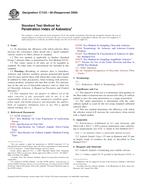Potřebujeme váš souhlas k využití jednotlivých dat, aby se vám mimo jiné mohly ukazovat informace týkající se vašich zájmů. Souhlas udělíte kliknutím na tlačítko „OK“.
ASTM C1609/C1609M-12
Standard Test Method for Flexural Performance of Fiber-Reinforced Concrete (Using Beam With Third-Point Loading)
Automaticky přeložený název:
Standardní zkušební metoda pro pevnost v ohybu výkonu Vláknový beton (pomocí Beam s třetí působiště zatížení)
NORMA vydána dne 1.12.2012
Informace o normě:
Označení normy: ASTM C1609/C1609M-12
Poznámka: NEPLATNÁ
Datum vydání normy: 1.12.2012
Kód zboží: NS-12008
Počet stran: 9
Přibližná hmotnost: 27 g (0.06 liber)
Země: Americká technická norma
Kategorie: Technické normy ASTM
Kategorie - podobné normy:
Anotace textu normy ASTM C1609/C1609M-12 :
Keywords:
fiber-reinforced concrete, first-peak strength, flexural toughness, peak strength, residual load, residual strength, ICS Number Code 91.100.40 (Products in fibre-reinforced cement)
Doplňující informace
| Significance and Use | ||||||||||||||||
|
5.1 The first-peak strength characterizes the flexural behavior of the fiber-reinforced concrete up to the onset of cracking, while residual strengths at specified deflections characterize the residual capacity after cracking. Specimen toughness is a measure of the energy absorption capacity of the test specimen. The appropriateness of each parameter depends on the nature of the proposed application and the level of acceptable cracking and deflection serviceability. Fiber-reinforced concrete is influenced in different ways by the amount and type of fibers in the concrete. In some cases, fibers may increase the residual load and toughness capacity at specified deflections while producing a first-peak strength equal to or only slightly greater than the flexural strength of the concrete without fibers. In other cases, fibers may significantly increase the first-peak and peak strengths while affecting a relatively small increase in residual load capacity and specimen toughness at specified deflections. 5.2 The first-peak strength, peak strength, and residual strengths determined by this test method reflect the behavior of fiber-reinforced concrete under static flexural loading. The absolute values of energy absorption obtained in this test are of little direct relevance to the performance of fiber-reinforced concrete structures since they depend directly on the size and shape of the specimen and the loading arrangement. 5.3 The results of this test method may be used for comparing the performance of various fiber-reinforced concrete mixtures or in research and development work. They may also be used to monitor concrete quality, to verify compliance with construction specifications, obtain flexural strength data on fiber-reinforced concrete members subject to pure bending, or to evaluate the quality of concrete in service. 5.4 The results of this standard test method are dependent on the size of the specimen. 1.1 This test method evaluates the
flexural performance of fiber-reinforced concrete using parameters
derived from the load-deflection curve obtained by testing a simply
supported beam under third-point loading using a closed-loop,
servo-controlled testing system.
1.2 This test method provides for the determination of first-peak and peak loads and the corresponding stresses calculated by inserting them in the formula for modulus of rupture given in Eq 1. It also requires determination of residual loads at specified deflections, the corresponding residual strengths calculated by inserting them in the formula for modulus of rupture given in Eq 1 (see Note 1). It provides for determination of specimen toughness based on the area under the load-deflection curve up to a prescribed deflection (see Note 2) and the corresponding equivalent flexural strength ratio. 1.3 This test method utilizes two
preferred specimen sizes of 100 by 100 by 350 mm [4 by 4 by 14 in.]
tested on a 300 mm [12 in.] span, or 150 by 150 by 500 mm [6 by 6
by 20 in.] tested on a 450 mm [18 in.] span. A specimen size
different from the two preferred specimen sizes is permissible.
1.4 Units—The values stated in either SI units or inch-pound units are to be regarded separately as standard. The values stated in each system may not be exact equivalents; therefore, each system shall be used independently of the other. Combining values from the two systems may result in non-conformance with the standard. 1.5 This standard does not purport to address all of the safety concerns, if any, associated with its use. It is the responsibility of the user of this standard to establish appropriate safety and health practices and determine the applicability of regulatory limitations prior to use. |
||||||||||||||||
| 2. Referenced Documents | ||||||||||||||||
|
Podobné normy:
Historická
1.11.2009
Historická
1.11.2011
Historická
1.11.2009
Historická
1.11.2012
Historická
15.12.2012
Historická
1.11.2012
Doporučujeme:
EviZak - všechny zákony včetně jejich evidence na jednom místě
Poskytování aktuálních informací o legislativních předpisech vyhlášených ve Sbírce zákonů od roku 1945.
Aktualizace 2x v měsíci !
Chcete vědět více informací? Podívejte se na tuto stránku.



 ASTM C1125-89(2009)..
ASTM C1125-89(2009).. ASTM C1154-06(2011)..
ASTM C1154-06(2011).. ASTM C1162/C1162M-90..
ASTM C1162/C1162M-90.. ASTM C1185-08(2012)..
ASTM C1185-08(2012).. ASTM C1186-08(2012)..
ASTM C1186-08(2012).. ASTM C1225-08(2012)..
ASTM C1225-08(2012)..
 Cookies
Cookies
